Analysis of the Projected Climate Impacts on the Interlinkages of Water, Energy, and Food Nexus Resources in Narok County, Kenya, and Vhembe District Municipality, South Africa
Abstract
1. Introduction
2. Materials and Methods
2.1. Description of the Study Sites (VDM and Narok County)
2.2. Bias Correction Approach
| Model | Institute (Country) | Reference |
|---|---|---|
| CanESM2m | CCCMa (Canada) | [20,29] |
| CNRM-CM5 | CNRM-CERFACS (France) | [30,31] |
| CSIRO-Mk3 | CSIRO-QCCCE (Australia) | [31] |
| IPSL-CM5A-MR | IPSL (France) | [20,32] |
| MICRO5 | AORI-NIES-JAMSTEC (Japan) | [33] |
| HadGEM2-ES | Hadley Centre (UK) | [34] |
| MPI-ESM-LR | MPI-M (Germany) | [20,35] |
| NorESMI-M | NCC (Norway) | [21,35] |
| GFDL-ESM2M | GFDL (USA) | [34] |
2.3. Case Study: Model Verification Against Observation
3. Results
3.1. Projected Temperature and Rainfall in Limpopo, Vhembe District Municipality
3.2. Projected Temperature and Rainfall in Narok County
3.3. How Projected Climate Change May Affect the Connections Between Water, Energy, and Food Nexus Resources
3.4. Developing a Modelling Framework Based on Questionnaire Responses
3.5. The Developed Framework
4. Discussion
- Identifying critical research needs and evaluating ecosystem service practices with the potential for multiple synergies and trade-offs. The proposed framework allows the timely identification of these conflicts and co-benefits for holistic, transformative, and transdisciplinary interventions.
- Simplifying the complexity and challenges associated with climate change and its impacts on water, energy, and food. The developed framework acts as a guide for policymakers to provide strategic interventions in various scenarios.
- The results are key in identifying knowledge gaps and future research needs, including developing a harmonised policy framework to guide the operationalisation of the WEF nexus.
- The results also indicate that transformative approaches do not work in silos, as each transformative approach is informed by the other. The present study has shown the interlinkages between the WEF nexus and scenario planning and how these can inform one health and horizon scanning.
5. Conclusions
Author Contributions
Funding
Data Availability Statement
Acknowledgments
Conflicts of Interest
References
- Muhirwa, F.; She, L.; Elshkaki, A.; Chiaka, J.C.; Zhong, S.; Bönecke, E.; Hirwa, H.; Seka, A.M.; Habiyakare, T.; Tuyishimire, A.; et al. Alert in the dynamics of water-energy-food production in African countries from a nexus perspective. Resour. Conserv. Recycl. 2023, 194, 106990. [Google Scholar] [CrossRef]
- Oliver, O.; Nnamdi, A.; Nwulu, I. The water-energy-food-ecosystem nexus scenario in Africa: Perspective and policy implementations. Energy Rep. 2024, 11, 5947–5962. [Google Scholar]
- Molefe, T.; Inglesi-Lotz, R. Examining the water–energy–food (WEF) nexus through an SDG lens for the big 5 African countries. Environ. Dev. Sustain. 2023, 25, 14083–14100. [Google Scholar] [CrossRef]
- Wakeford, J.J. The water–energy–food nexus in a climate-vulnerable, frontier economy: The case of Kenya. Rep. Prep. United Kingd. Dep. Int. Dev. Sustain. Inst. S. Afr. 2017, 3, 1–29. [Google Scholar]
- Kanda, E.K.; Lusweti, E.; Odhiambo, K.O. Water–energy–food nexus in Kenya: A review of policy interventions. World Water Policy 2023, 9, 823–836. [Google Scholar] [CrossRef]
- Mabhaudhi, T.; Simpson, G.; Badenhorst, J.; Mohammed, M.; Motongera, T.; Senzanje, A.; Jewitt, A.; Naidoo, D.; Mpandeli, S. Assessing the state of the water-energy-food (WEF) nexus in South Africa. Water Res. Comm. (WRC) Pretoria S. Afr. 2018, 76, 126. [Google Scholar]
- David, L.O.; Aigbavboa, C.; Nwulu, N.; Adepoju, O.O. Water, Energy, and Food (WEF) Resources in South Africa. In Sustainable Synergy: A Digital Framework for the Water-Energy-Food Nexus Project Delivery in Developing Economies; Springer: Cham, Switzerland, 2024; pp. 197–217. [Google Scholar]
- Botai, C.M.; Botai, J.O.; Tazvinga, H.; Murambadoro, M.; Nhamo, L.; Ncongwane, K.P.; Mengistu, M.G.; Zwane, N.; Wamiti, E.; Mpandeli, S.; et al. Assessment of rural livelihoods, health and wellbeing in Vhembe District Municipality, South Africa and Narok County, Kenya: A water-energy-food nexus perspective. Environ. Sci. Policy 2024, 159, 103817. [Google Scholar] [CrossRef]
- Zwane, N.; Botai, J.O.; Botai, C.M.; Mabhaudhi, T. Sustainability of the Linkages Between Water–Energy–Food Resources Based on Structural Equation Modeling Under Changing Climate: A Case Study of Narok County (Kenya) and Vhembe District Municipality (South Africa). Sustainability 2024, 16, 9689. [Google Scholar] [CrossRef]
- Intergovernmental Panel on Climate Change (IPCC). Climate change 2021: The physical science basis. In Contribution of Working Group I to the Sixth Assessment Report of the Intergovernmental Panel on Climate Change; Masson-Delmotte, V., Zhai, P., Pirani, A., Connors, S.L., Péan, C., Berger, S., Caud, N., Chen, Y., Goldfarb, L., Gomis, M.I., et al., Eds.; Cambridge University Press: Cambridge, UK, 2021; Available online: https://www.ipcc.ch/report/ar6/wg1/ (accessed on 1 November 2024).
- Field, C.B.; Barros, V.R. (Eds.) Climate Change 2014-Impacts, Adaptation and Vulnerability: Regional Aspects; Cambridge University Press: Cambridge, UK, 2014. [Google Scholar]
- Engelbrecht, F.; Adegoke, J.; Bopape, M.J.; Naidoo, M.; Garland, R.; Thatcher, M.; McGregor, J.; Katzfey, J.; Werner, M.; Ichoku, C.; et al. Projections of rapidly rising surface temperatures over Africa under low mitigation. Environ. Res. Lett. 2015, 10, 085004. [Google Scholar] [CrossRef]
- Mbokodo, I.; Bopape, M.J.; Chikoore, H.; Engelbrecht, F.; Nethengwe, N. Heatwaves in the future warmer climate of South Africa. Atmosphere 2020, 11, 712. [Google Scholar] [CrossRef]
- McBride, C.M.; Kruger, A.C.; Dyson, L. Trends in Probabilities of Temperature Records in the Non-Stationary Climate of South Africa. Int. J. Clim. 2021, 42, 1692–1705. [Google Scholar] [CrossRef]
- Ihinegbu, C. Conceptualization and management of disasters and climate change events in Africa: A review. SN Appl. Sci. 2021, 3, 848. [Google Scholar] [CrossRef]
- Mulwa, F.; Li, Z.; Fangninou, F.F. Water scarcity in Kenya: Current status, challenges and future solutions. Open Access Libr. J. 2021, 8, 1–5. [Google Scholar] [CrossRef]
- Korir, J.; Ngenoh, E. Factors Influencing the Adaptation Decisions to Impacts of Climate Change among the Maasai Pastoral Community in Narok County, Kenya. Agric. Sci. 2019, 10, 689–705. [Google Scholar] [CrossRef]
- Botai, C.M.; Botai, J.O.; de Wit, J.C.; Ncongwane, K.P.; Adeola, A.M. Drought characteristics over the Western Cape Province, South Africa. Water 2017, 9, 876. [Google Scholar] [CrossRef]
- Botai, C.M.; Botai, J.O.; Dlamini, L.; Zwane, N.; Phaduli, E. Characteristics of Droughts in South Africa: A Case Study of Free State and North West Provinces. Water 2016, 8, 439. [Google Scholar] [CrossRef]
- Botai, C.M.; Botai, J.O.; de Wit, J.P.; Ncongwane, K.P.; Murambadoro, M.; Barasa, P.M.; Adeola, A.M. Hydrological Drought Assessment Based on the Standardized Streamflow Index: A Case Study of the Three Cape Provinces of South Africa. Water 2021, 13, 3498. [Google Scholar] [CrossRef]
- Omambia, A.N.; Shemsanga, C.; Li, Y. Combating climate change in Kenya: Efforts, challenges and opportunities. Rep. Opin. 2009, 1, 12–23. [Google Scholar]
- Almulhim, A.I.; Alverio, G.N.; Sharifi, A.; Shaw, R.; Huq, S.; Mahmud, M.J.; Ahmad, S.; Abubakar, I.R. Climate-induced migration in the Global South: An in-depth analysis. Npj Clim. Action 2024, 3, 47. [Google Scholar] [CrossRef]
- Bazilian, M.; Rogner, H.; Howells, M.; Hermann, S.; Arent, D.; Gielen, D.; Steduto, P.; Mueller, A.; Komor, P.; Tol, R.J.; et al. Considering the energy, water and food nexus: Towards an integrated modelling approach. Energy Policy 2011, 39, 7896–7906. [Google Scholar] [CrossRef]
- van Vuuren, D.P.; Nakicenovic, N.; Riahi, K.; Brew-Hammond, A.; Kammen, D.; Modi, V.; Nilsson, M.; Smith, K.R. An energy vision: The transformation towards sustainability—Interconnected challenges and solutions. Curr. Opin Env. Sustain. 2012, 4, 18–34. [Google Scholar] [CrossRef]
- Adom, R.K.; Simatele, M.D.; Reid, M. Addressing the challenges of water-energy-food nexus programme in the context of sustainable development and climate change in South Africa. J. Water Clim. Chang. 2022, 13, 2721. [Google Scholar] [CrossRef]
- SAWS. Launch of the Climate Change Reference Atlas. 2017. Available online: https://www.weathersa.co.za/home/climatechangeatlas (accessed on 24 October 2024).
- Kenya County Climate Risk Profile 2021. Available online: https://climateknowledgeportal.worldbank.org/sites/default/files/2021-05/15724-WB_Kenya%20Country%20Profile-WEB.pdf (accessed on 24 October 2024).
- Georgakakos, K.P.; Seo, D.J.; Gupta, H.; Schaake, J.; Butts, M.B. Towards the characterization of streamflow simulation uncertainty through multi-model ensembles. J. Hydrol. 2004, 298, 222–241. [Google Scholar] [CrossRef]
- Arora, V.K.; Scinocca, J.F.; Boer, G.J.; Christian, J.R.; Denman, K.L.; Flato, G.M.; Kharin, V.V.; Lee, W.G.; Merryfield, W.J. Carbon emission limits required to satisfy future representative concentration pathways of greenhouse gases. Geophys. Res. Lett. 2011, 38, 1–6. [Google Scholar] [CrossRef]
- Voldoire, A.; Sanchez-Gomez, E.; Salas y Mélia, D.; Decharme, B.; Cassou, C.; Sénési, S.; Valcke, S.; Beau, I.; Alias, A.; Chevallier, M.; et al. The CNRM-CM5. 1 global climate model: Description and basic evaluation. Clim. Dyn. 2013, 40, 2091–2121. [Google Scholar] [CrossRef]
- Aloysius, N.R.; Sheffield, J.; Saiers, J.E.; Li, H.; Wood, E.F. Evaluation of historical and future simulations of precipitation and temperature in central Africa from CMIP 5 climate models. J. Geophys. Res. Atmos. 2015, 121, 130–152. [Google Scholar] [CrossRef]
- Hourdin, F.; Foujols, M.A.; Codron, F.; Guemas, V.; Dufresne, J.L.; Bony, S.; Denvil, S.; Guez, L.; Lott, F.; Ghattas, J.; et al. Impact of the LMDZ atmospheric grid configuration on the climate and sensitivity of the IPSL-CM5A coupled model. Clim. Dyn. 2013, 40, 2167–2192. [Google Scholar] [CrossRef]
- Watanabe, S.; Hajima, T.; Sudo, K.; Nagashima, T.; Takemura, T.; Okajima, H.; Nozawa, T.; Kawase, H.; Abe, M.; Yokohata, T.J.G.M.D.; et al. MIROC-ESM 2010: Model description and basic results of CMIP5-20c3m experiments. Geosci. Model Dev. 2011, 4, 845–872. [Google Scholar] [CrossRef]
- Dunne, J.P.; John, J.G.; Adcroft, A.J.; Griffies, S.M.; Hallberg, R.W.; Shevliakova, E.; Stouffer, R.J.; Cooke, W.; Dunne, K.A.; Harrison, M.J.; et al. GFDL’s ESM2 global coupled climate-carbon earth system models. Part I: Physical formulation and baseline simulation char-acteristics. J. Clim. 2012, 25, 6646–6665. [Google Scholar] [CrossRef]
- Tjiputra, J.F.; Roelandt, C.; Bentsen, M.; Lawrence, D.M.; Lorentzen, T.; Schwinger, J.; Seland, Ø.; Heinze, C. Evaluation of the carbon cycle components in the Norwegian Earth System Model (NorESM). Geosci. Model Dev. 2013, 6, 301–325. [Google Scholar] [CrossRef]
- Nesamvuni, A.E.; Tshikolomo, K.A.; Mpandeli, N.S.; De Bruyn, M.; Hlophe-Ginindza, S.; Van Niekerk, J. Perceptions on irrigation water supply and utilisation by smallholder agricultural enterprises in Vhembe district of Limpopo Province, South Africa. Tech. Soc. Sci. J. 2022, 27, 968–979. [Google Scholar] [CrossRef]
- Oni, S.A.; Maliwichi, L.L.; Obadire, O.S. Socio-Economic Factors Affecting Smallholder Farming and Household Food Security: A Case of Thulamela Local Municipality in Vhembe District of Limpopo Province, South Africa. Afr. J. Agric. Res. 2010, 5, 2289–2296. [Google Scholar]
- Zwane, N. Investigating the Influence of Present and Projected Climate on the Livelihood of Small-Scale Farmers in the Uthungulu District Municipality, KwaZulu Natal, South Africa. Ph.D. Thesis, University of Pretoria, Pretoria, South Africa, 2019. Available online: http://hdl.handle.net/2263/70346 (accessed on 1 November 2024).
- Mpandeli, S.; Naidoo, D.; Mabhaudhi, T.; Nhemachema, C.; Nhamo, L.; Liphandzi, S.; Hlahla, S.; Modi, A.T. Climate change adaptation through the water-energy-food nexus in Southern Africa. Int. J. Environ. Res. Public Health 2018, 15, 2306. [Google Scholar] [CrossRef] [PubMed]
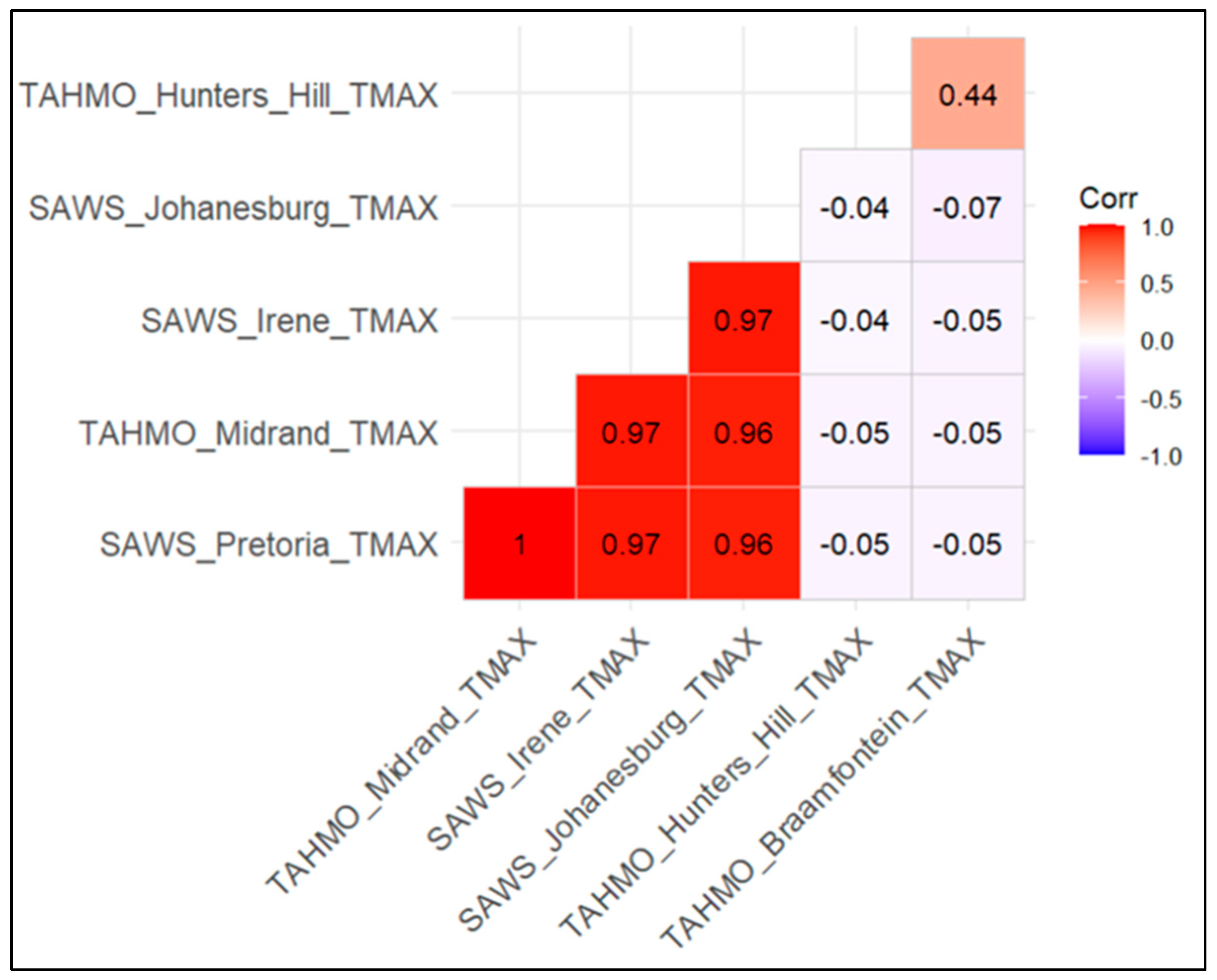

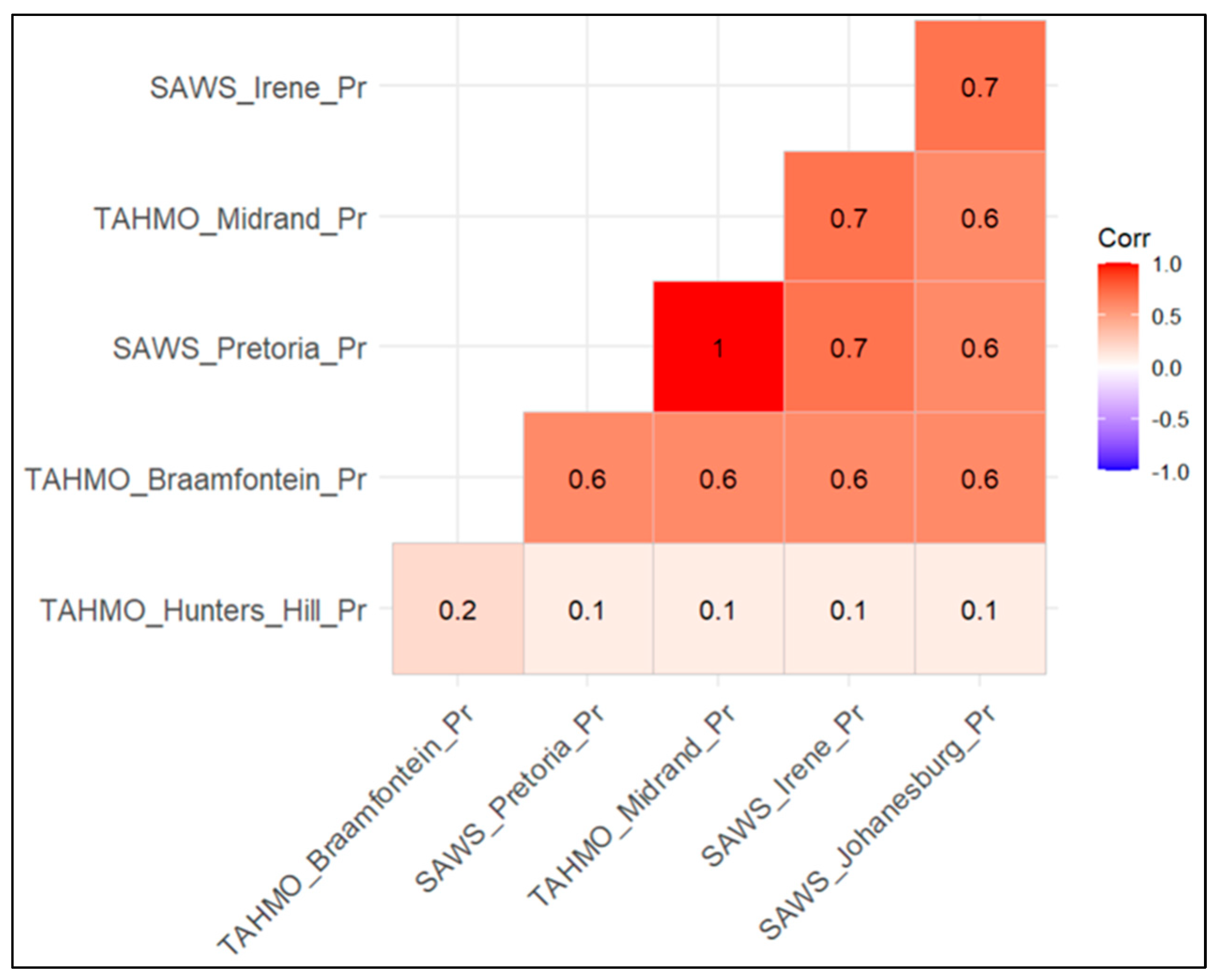

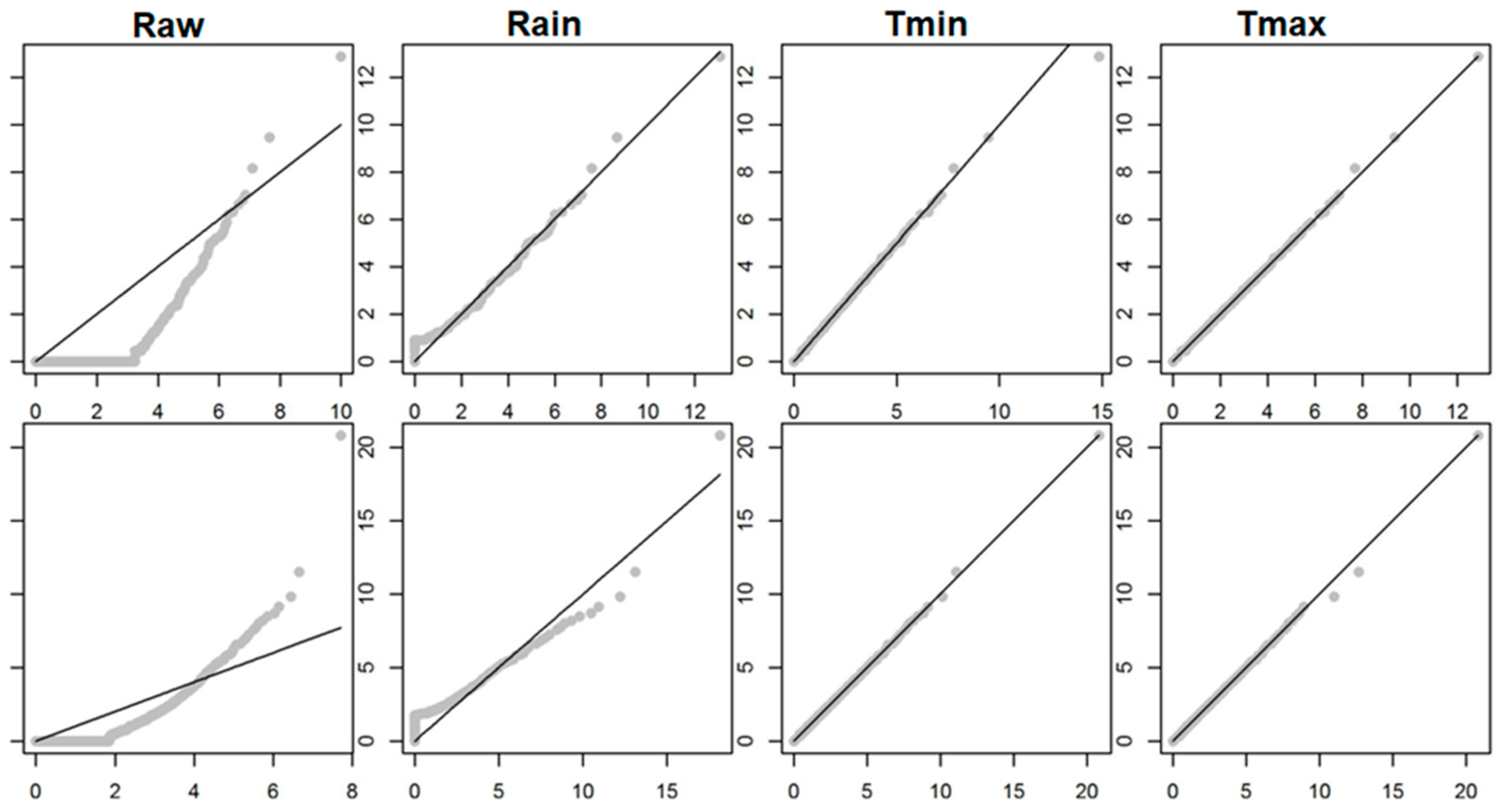


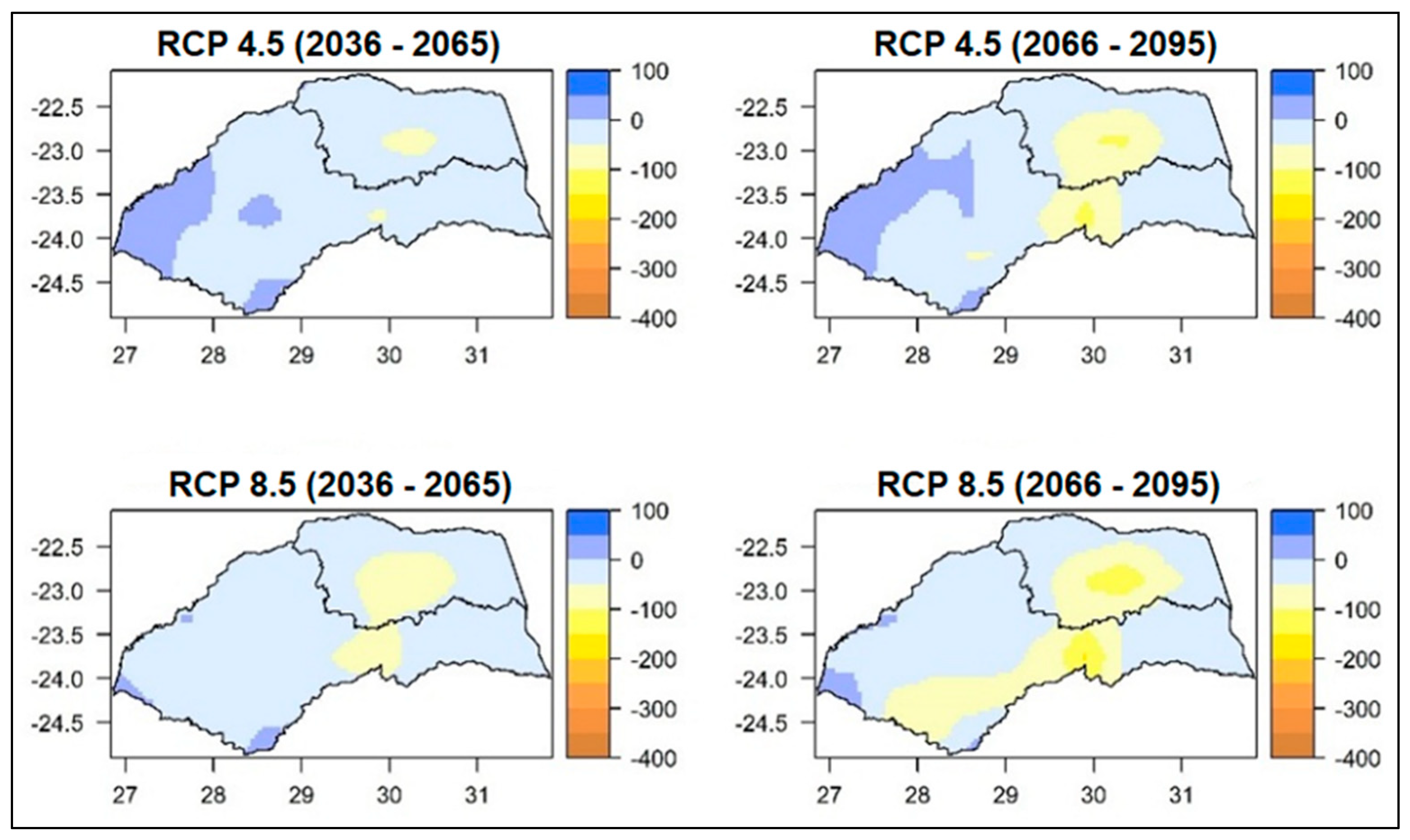
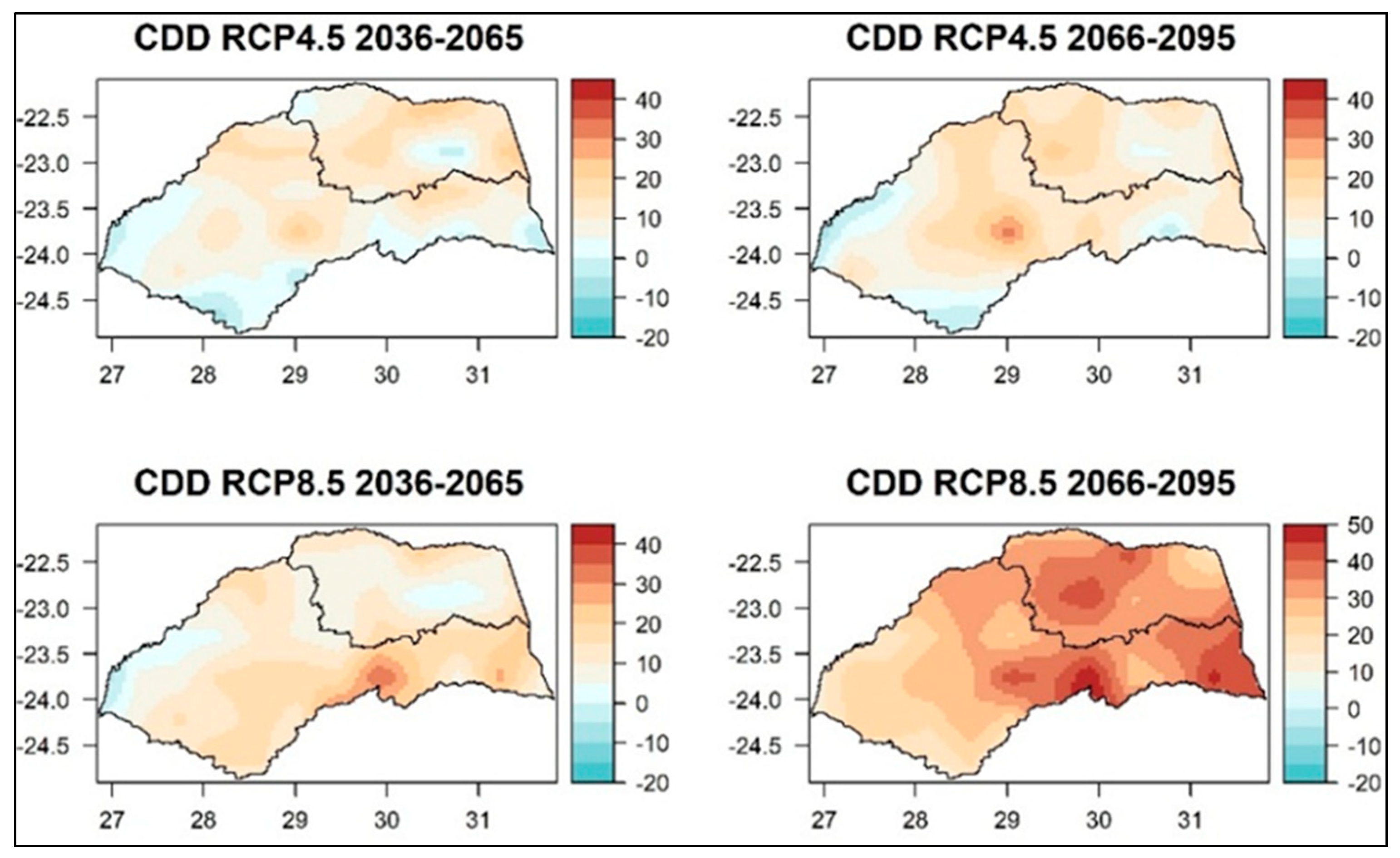

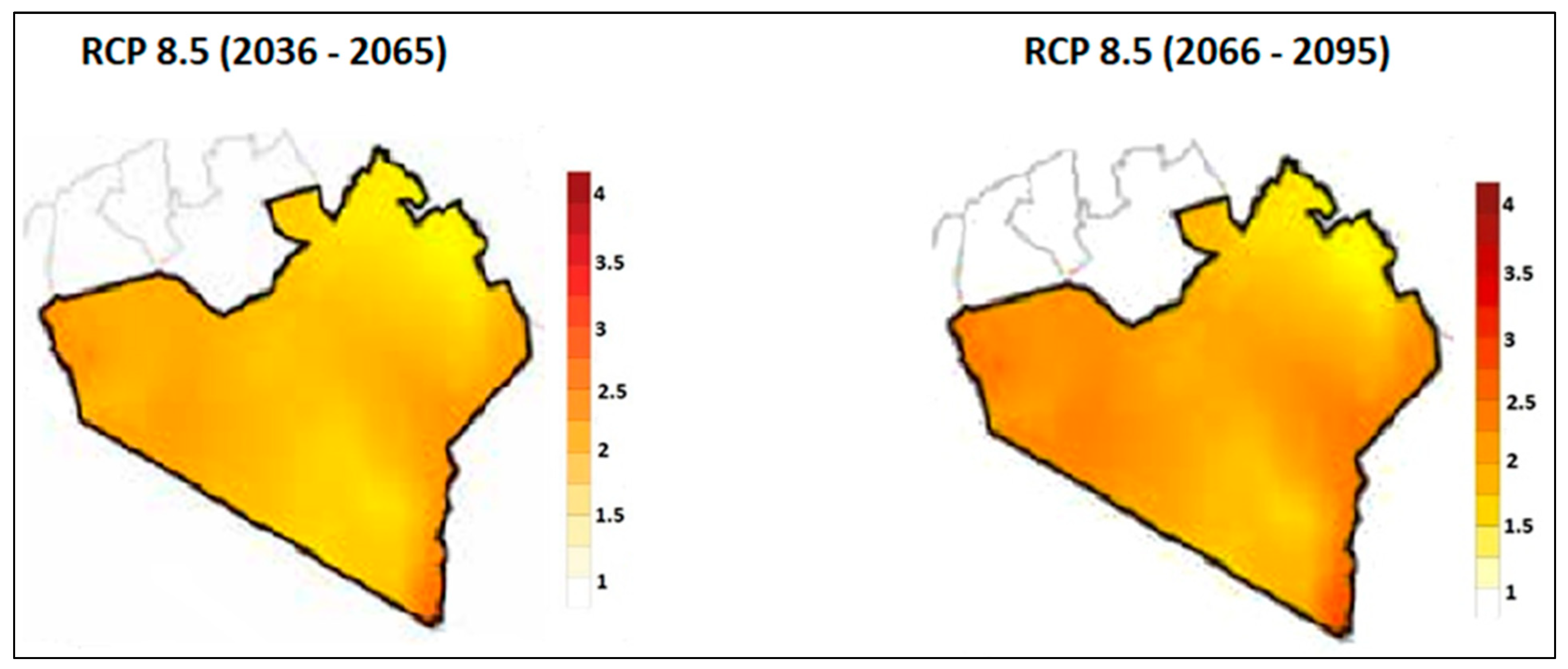
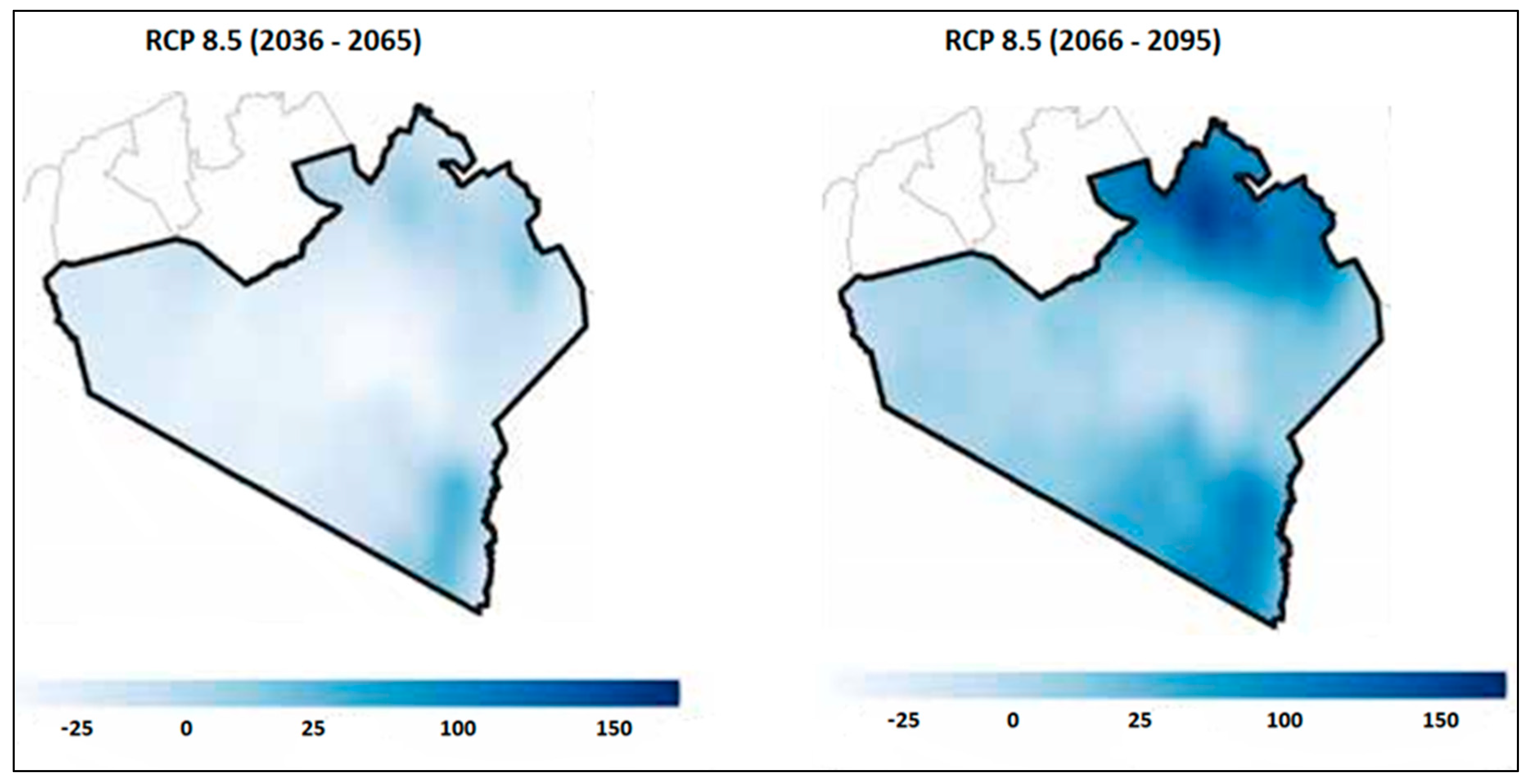
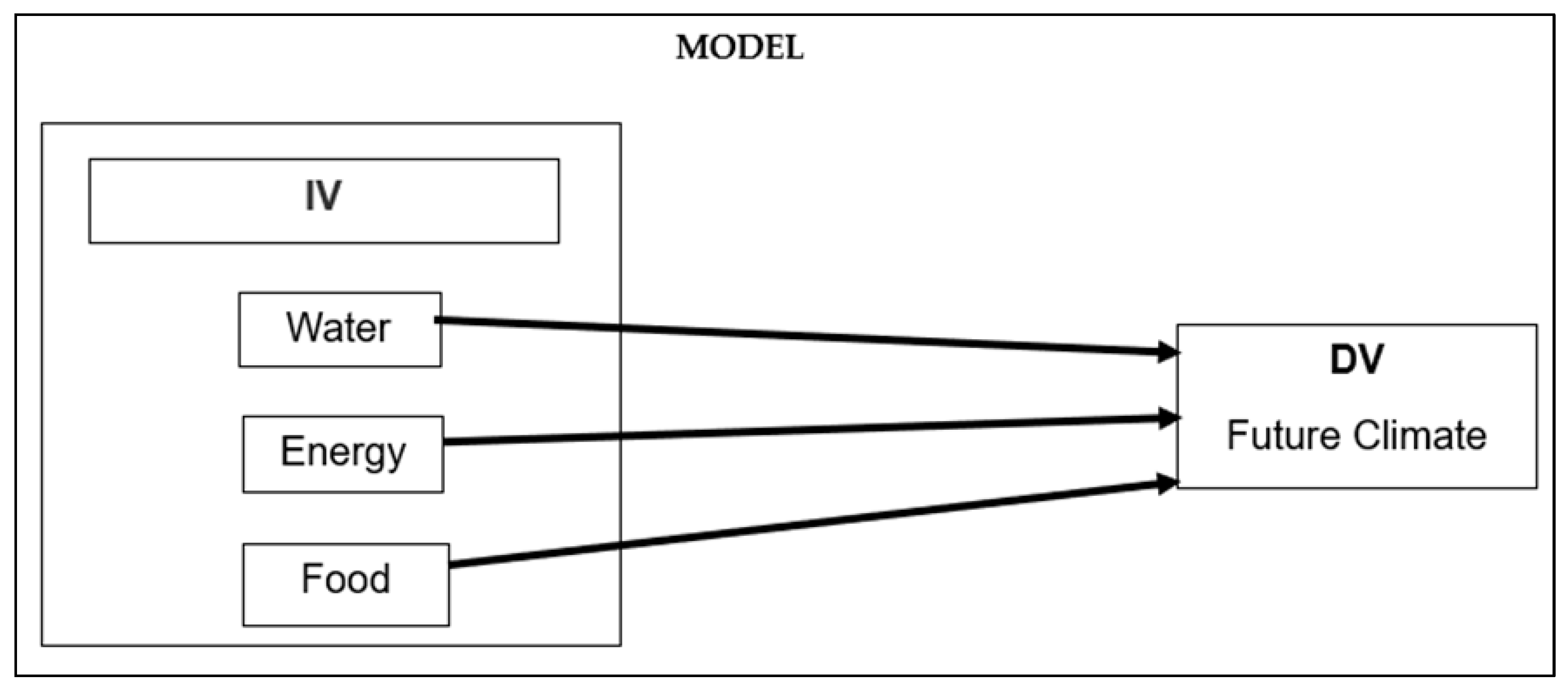


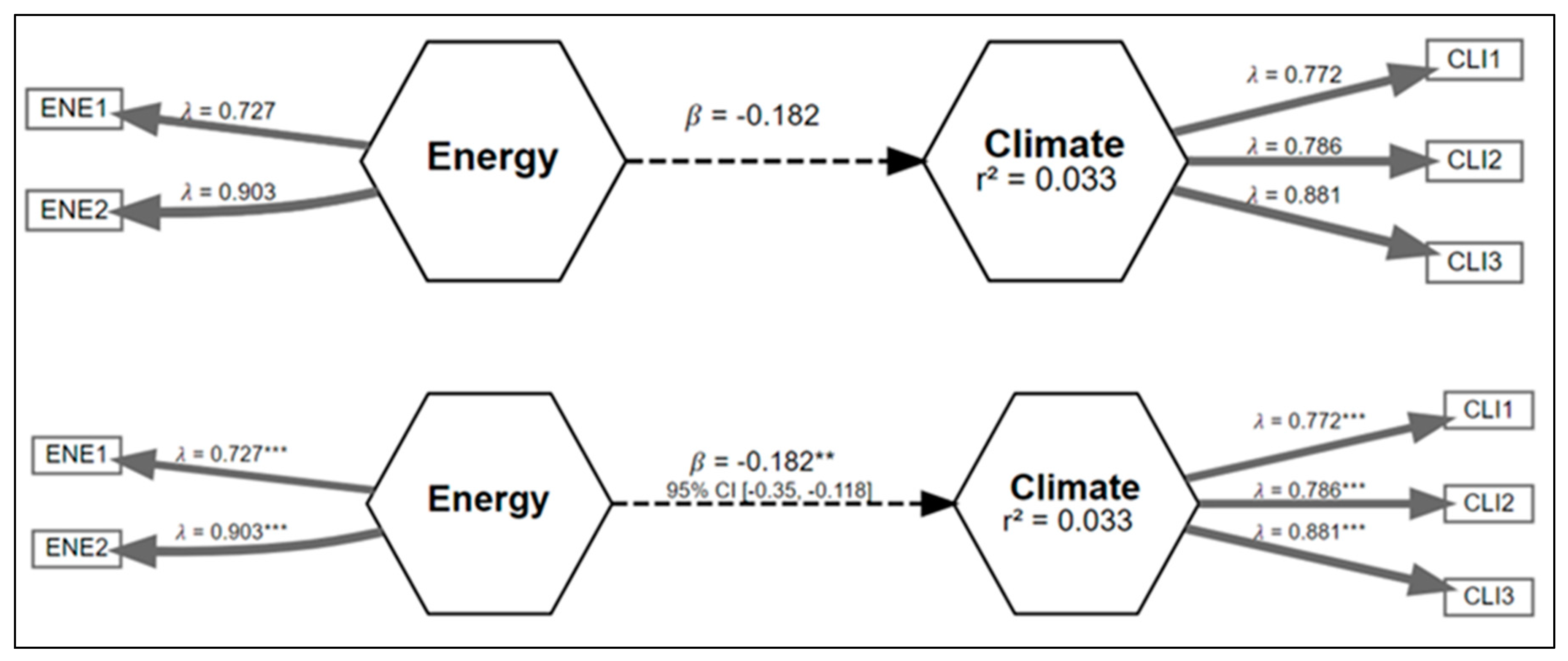

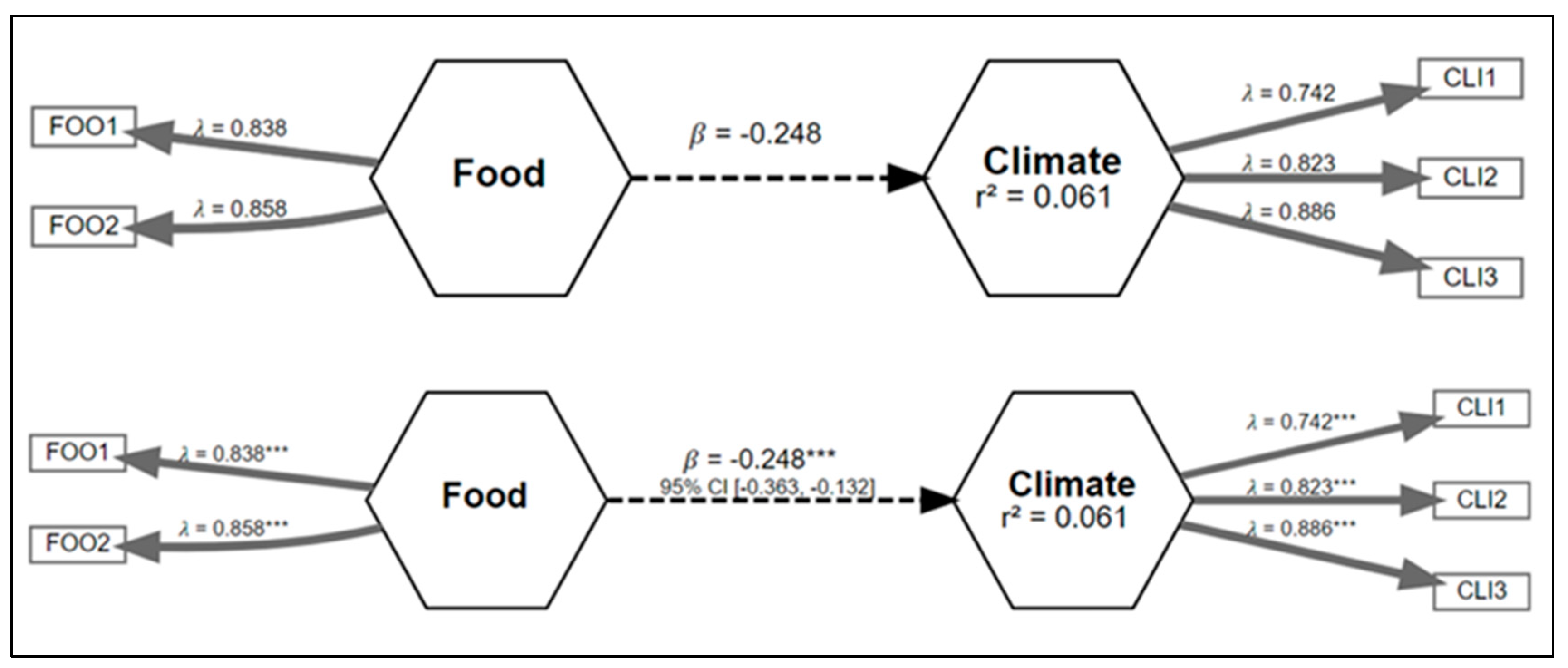
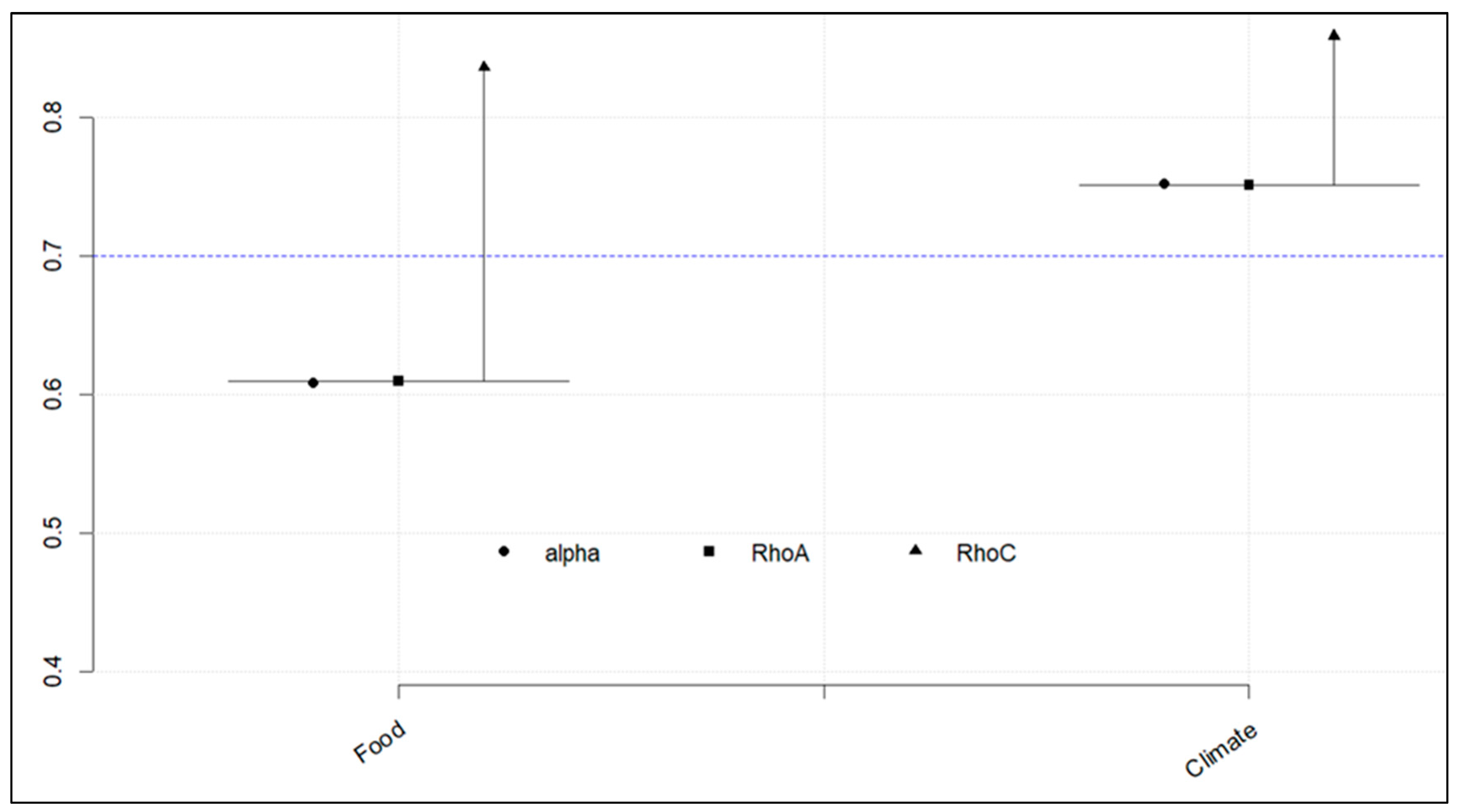
| Station | Latitude | Longitude | Altitude |
|---|---|---|---|
| Thohoyandou | −22.97 | 30.50 | 600 |
| Polokwane | −23.87 | 29.45 | 1300 |
| Levubu | −23.09 | 30.29 | 650 |
| Oudestad | −25.18 | 29.34 | 944 |
| Giyani | −23.32 | 30.68 | 455 |
| Mara | −23.14 | 29.56 | 894 |
| Phalaborwa | −23.93 | 31.15 | 432 |
| Station Name | Station Code | Latitude | Longitude | Altitude |
|---|---|---|---|---|
| Lela Primary School | TA00001 | −0.18 | 34.89 | 1156 |
| Koyoo Secondary School | TA00018 | −0.58 | 34.61 | 847 |
| Osodo Secondary School | TA00019 | −0.75 | 34.35 | 546 |
| Woodlands 2000 Trust | TA00020 | −1.65 | 36.86 | 750 |
| Kipsombe Secondary School | TA00021 | 0.76 | 35.17 | 2725 |
| Bubayi-Saboti Farm | TA00022 | 0.91 | 34.92 | 1794 |
| Dwa Estate | TA00023 | −2.39 | 38.01 | 884 |
| Mang’u High School | TA00024 | −1.07 | 37.04 | 1600 |
| Kenya Meteorological Department | TA00025 | −1.13496 | 36.76887 | 1795 |
Disclaimer/Publisher’s Note: The statements, opinions and data contained in all publications are solely those of the individual author(s) and contributor(s) and not of MDPI and/or the editor(s). MDPI and/or the editor(s) disclaim responsibility for any injury to people or property resulting from any ideas, methods, instructions or products referred to in the content. |
© 2025 by the authors. Licensee MDPI, Basel, Switzerland. This article is an open access article distributed under the terms and conditions of the Creative Commons Attribution (CC BY) license (https://creativecommons.org/licenses/by/4.0/).
Share and Cite
Zwane, N.; Botai, J.O.; Nozwane, S.H.; Jabe, A.; Botai, C.M.; Dlamini, L.; Nhamo, L.; Mpandeli, S.; Petja, B.; Isaac, M.; et al. Analysis of the Projected Climate Impacts on the Interlinkages of Water, Energy, and Food Nexus Resources in Narok County, Kenya, and Vhembe District Municipality, South Africa. Water 2025, 17, 1449. https://doi.org/10.3390/w17101449
Zwane N, Botai JO, Nozwane SH, Jabe A, Botai CM, Dlamini L, Nhamo L, Mpandeli S, Petja B, Isaac M, et al. Analysis of the Projected Climate Impacts on the Interlinkages of Water, Energy, and Food Nexus Resources in Narok County, Kenya, and Vhembe District Municipality, South Africa. Water. 2025; 17(10):1449. https://doi.org/10.3390/w17101449
Chicago/Turabian StyleZwane, Nosipho, Joel O. Botai, Siyabonga H. Nozwane, Aphinda Jabe, Christina M. Botai, Lucky Dlamini, Luxon Nhamo, Sylvester Mpandeli, Brilliant Petja, Motochi Isaac, and et al. 2025. "Analysis of the Projected Climate Impacts on the Interlinkages of Water, Energy, and Food Nexus Resources in Narok County, Kenya, and Vhembe District Municipality, South Africa" Water 17, no. 10: 1449. https://doi.org/10.3390/w17101449
APA StyleZwane, N., Botai, J. O., Nozwane, S. H., Jabe, A., Botai, C. M., Dlamini, L., Nhamo, L., Mpandeli, S., Petja, B., Isaac, M., & Mabhaudhi, T. (2025). Analysis of the Projected Climate Impacts on the Interlinkages of Water, Energy, and Food Nexus Resources in Narok County, Kenya, and Vhembe District Municipality, South Africa. Water, 17(10), 1449. https://doi.org/10.3390/w17101449








